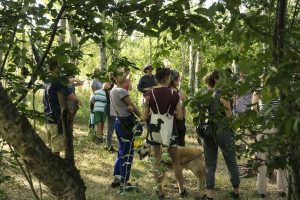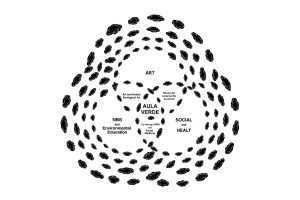From the outskirts of Rome to the most prestigious American universities: art, science, and ecology to imagine new shared landscapes.

Rome / Burlington (Vermont), October 2025 —
The Aule Verdi – Tree Room method, which originated in the suburbs of Rome from the encounter between contemporary art, science, and ecology, has arrived in the United States. The project, conceived by artist and environmental engineer Andrea Conte (Andreco) and researcher Laura Passatore of CNR–IRET, has been invited for a series of presentations, workshops, and lectures at leading American universities, including the University of Vermont, the Fleming Museum of Art, and Duke University.
The Aule Verdi – Tree Rooms are environmental works of art and Nature-Based Solutions (NBS): circular installations of trees and shrubs that create outdoor meeting and socializing spaces, veritable “green living rooms” for the community. The method combines ecological regeneration, psychosocial well-being, and civic participation, offering a new model of artistic and social reforestation.
Published in the scientific journal Nature Scientific Reports, the method has already been presented at several international conferences, including FLARE, where it was noticed by US researchers and curators who invited the team to undertake this academic tour overseas.
“The Aule Verdi were created as an experiment in social ecology, a way to combine the growth of plants with the growth of human relationships,” explains Andreco, “a form of public art that becomes an infrastructure for care and regeneration.”
“Our goal is to propose a replicable model capable of improving the microclimate and urban biodiversity with a participatory and scientifically measurable approach,” adds Laura Passatore of CNR–IRET.

The first Aula Verde – Tree Room was created in the Aniene Valley Nature Reserve (IV Municipality of Rome), followed by the major project currently underway in the Third Municipality (Vigne Nuove) as part of the European We-Z – Wellbeing for Generation Z project, winner of the European Urban Initiative (EUI) call for proposals dedicated to urban innovation and the psychological and physical wellbeing of young people.
In 2026, the method will also be tested in Milan, in Bosco della Goccia in Bovisa, as part of a new urban regeneration project.
Press contacts
Studio Andreco / Futurecologies
📧 info@andreco.org
🌍 www.futurecologies.com | www.andreco.org
laura.passatore@cnr.it

